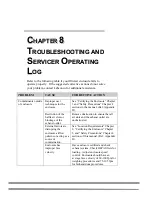
48
Chapter 6: Maintaining Your Filtered Enclosure
5. Adjust the inflow velocity to the nominal operating point
required by your Safety Officer.
6. Over time the HEPA filter will load and eventually slow
the inflow velocity. Once the alarm condition is met,
simply increase the speed control outlined in Chapter 6 or
replace the HEPA filter if the speed control is maximized.
7. The table below lists typical alarm conditions based on
normal operating conditions. Typical alarm conditions are
set at face velocities of 10 to 30 feet per minute below the
normal operating conditions due to supply air and exhaust
air fluctuations, as well as room air cross drafts. Consult
your Safety Officer for proper operating speeds.
Enclosure Operating In-Flow
Speed
Alarm Condition Set Point
Speed
100 ± 10 fpm
70-90 fpm
90 ± 10 fpm
60-80 fpm
80 ± 10 fpm
50-70 fpm
70 ± 10 fpm
50-60 fpm
60 ± 10 fpm
50 fpm
Summary of Contents for 3980200
Page 2: ......
Page 13: ...8 Chapter 2 Prerequisites ...
Page 17: ...12 Chapter 3 Getting Started Figure 3 1 Filtered Enclosure Installation ...
Page 67: ...62 Chapter 7 Accessorizing and Modifying Your Filtered Enclosure ...
Page 82: ...77 Appendix C Filtered Enclosure Specifications C 1 ...
Page 83: ...78 Appendix C Filtered Enclosure Specifications C 2 ...
Page 84: ...79 Appendix C Filtered Enclosure Specifications C 3 ...
Page 85: ...80 Appendix C Filtered Enclosure Specifications C 4 ...
Page 92: ...87 ...
Page 93: ......
















































